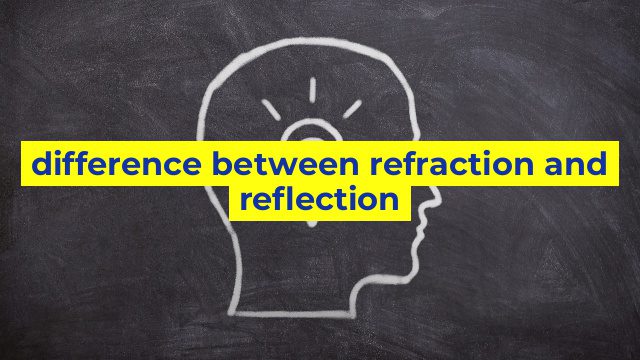The Difference Between Refraction and Reflection: Understanding the Science Behind Optics
When it comes to optics, there are two important concepts to understand – refraction and reflection. While both of these terms relate to the way light behaves when it interacts with a surface or object, they are quite different from one another.
What is Refraction?
Refraction is a phenomenon that occurs when light passes through a medium, such as air, water, or glass, and changes direction. This happens because light travels at different speeds in different mediums. When light enters a medium with a higher refractive index, it slows down and bends towards the normal (an imaginary line perpendicular to the surface of the medium). When it enters a medium with a lower refractive index, it speeds up and bends away from the normal.
For example, if you put a straw in a glass of water, it will appear bent at the point where it enters the water. This is because light passing through the water is refracted, or bent, and this makes the image of the straw appear to be bent as well.
Refraction is also responsible for many of the optical illusions that we see in our everyday lives. For instance, mirages are caused by the refraction of light through layers of air with different temperatures, creating the illusion of a reflective surface on the ground.
What is Reflection?
Reflection, on the other hand, occurs when light bounces off a surface or object and changes direction. This happens because the surface of the object reflects some of the light that hits it. The angle of reflection is equal to the angle of incidence (the angle at which the light hits the surface).
A mirror is a perfect example of reflection. When light hits the smooth surface of the mirror, it is reflected back out in the exact same direction. The reflection is said to be “specular” because it forms a sharp, clear image.
Reflection is also responsible for the way we perceive color. When a surface reflects all colors of light equally, it appears white. When it absorbs all colors of light, it appears black. When it reflects only certain colors, it appears to be the color of the reflected light.
The Importance of Refraction and Reflection in Optics
Understanding the concepts of refraction and reflection is essential when it comes to creating and using optical devices, such as cameras, microscopes, and telescopes. These devices rely on lenses and mirrors to manipulate the way light behaves in order to create clear and accurate images.
For example, a camera lens is designed to refract light in specific ways in order to focus the image onto the film or image sensor. Microscopes use lenses to magnify tiny details, and telescopes use mirrors to capture and reflect light from distant stars and planets.
In conclusion, while both refraction and reflection are related to the way that light interacts with surfaces and objects, they are quite different phenomena. Understanding their differences is crucial if you want to have a clearer understanding of optics and the science of light.
Table difference between refraction and reflection
| Refraction | Reflection |
| Refraction is the bending of light as it passes through a medium with different optical density. | Reflection is the bouncing back of light from a surface. |
| Refraction occurs when light changes its speed and direction as it passes through different media. | Reflection occurs when light reflects off a surface, with the angle of incidence equal to the angle of reflection. |
| Refraction can cause optical illusions, such as the bending of a straw in a glass of water. | Reflection can cause images to appear reversed, such as in a mirror. |
| Refraction is important in optics and is used in the bending of lenses to focus light. | Reflection is utilized in many applications, such as in telescopes, microscopes, and fiber optics. |

